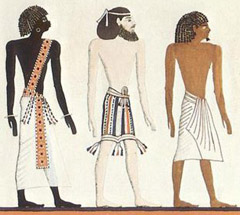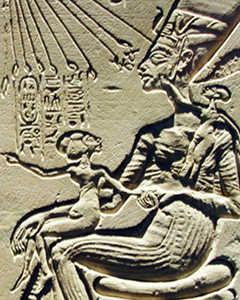|
Ancient Egypt
The Great Nile River of Egypt, with its abundance of fresh water supply in the midst of the largest desert of the world has always served as a beacon of life, prosperity and civilization. The Nile River Valley was the cradle of one of the oldest, and for many millennia, the most advanced civilization on Earth. Every year without fail, the Nile would overflow it's banks, providing a natural irrigation system for the adjacent farmland and creating the crop surpluses needed for the development of a non food producing elite, and the warriors, artists, and officials needed for the development of civilization. Outside of the fertile valley of the Nile, Egypt is almost entirely a desert, which meant that once people settled there, it was almost impossible for them to leave. This factor served to strengthen the power of a central state by making it easier to raise taxes, levy armies, and enforce laws. The Nile also encouraged trade and communication between settlements by easing the flow of people and goods via riverine transport. It was therefore not surprising that Egypt would develop one of the world's oldest state societies.
The First Unification of Egypt
Ancient Egypt was divided into 2 distinct regions: Upper Egypt and Lower Egypt. The terminology "Upper" and "Lower" derives from the flow of the Nile from the south northwards to the Mediterranean Sea, so Upper Egypt lies to the south of Lower Egypt. (See Map 1) The first documented unification of Upper and Lower Egypt into a single Kingdom is recorded on the Narmer Palette dated to about 3100 BC. The artifact depicts King Narmer defeating his enemies and wearing the traditional crowns of both Upper and Lower Egypt. From this point on, the Pharoahs (Kings) who ruled over the Nile Valley during Egypt's most prosperous times (the Old Kingdom, the Middle Kingdom, and the New Kingdom) were known as the rulers of the 'Two Kingdoms' , and wore the pschent, a double crown, each half representing sovereignty of one of the kingdoms. Nevertheless, whenever Egypt went through darker, less prosperous times (known as the "intermediate" periods), there was a tendency towards fractionalization into 2 or more separate states .
The Old Kingdom: the Age of the Pyramids
The Old Kingdom was Egypt's first "Golden Age". It lasted from 2686 BC – 2181 BC and was the period of the most prolific pyramid construction. Most of the Pyramids were constructed in Lower Egypt, near the Old Kingdom capital at Memphis. (See Map 2) It was also the period where Egyptian art, culture, religion and society developed it's unique flavor that would remain intact throughout the ancient period.
To legitimize their rule, the rulers of Egypt promoted the idea that they were living Gods. Thus the Pharaoh was supposedly the son of the sun God Ra, and was the living embodiment of Horus (the God of the Sky), and would transform into Osiris (God of the afterlife) after his death. The notion may seem silly to us today, but there is overwhelming evidence that the common people of Egypt believed these ideas. So that when foreign rulers came to conquer Egypt, if they did not also proclaim themselves as Egyptian Gods, they would be hated by the local populace. The promotion of a divine ruler was a stabilizing force, and would be copied and adapted outside of Egypt, throughout history, again and again.
The Old Kingdom of Egypt came to an end during the First Intermediate Period, where once again Egypt became divided into Upper and Lower Egypt. In Lower Egypt the 7th and 8th dynasties ruled from Memphis, they were then superseded by the 9th and 10th Dynasties who ruled Lower Egypt from Heracleopolis. Meanwhile, Upper Egypt was ruled from the city of Thebes by the 11th Dynasty. (See Map 3).
 Depiction of a Nubian (left), an Assyrian (middle), and an Egyptian (right) from the Tomb of Pharaoh Seti I.
Depiction of a Nubian (left), an Assyrian (middle), and an Egyptian (right) from the Tomb of Pharaoh Seti I.
The Middle Kingdom
Egypt was reunited when Pharaoh Mentuhotep II of Upper Egypt conquered Lower Egypt. This ushered in a new period of unity and prosperity known as the Middle Kingdom (See Map 4). One of the most famous Pharaohs of the Middle Kingdom was Senusret III, a warrior King who expanded the territory of Egypt in the south towards Nubia, he built a navigable canal through the first cataract of the Nile, allowing ships to travel through Egypt to Nubia, and he built defensive fortifications on the border with Nubia at Semna. (See Map 4) The Middle Kingdom came to end during the Second Intermediate Period when Egypt again split into 2 separate states as Lower Egypt was conquered by the Hyksos who arrived from Asia. (See Map 5)
The New Kingdom
Egypt was reunited for a third time when the native Egyptian rulers of Thebes reconquered Lower Egypt from the Hyksos. This brought about the beginning of the New Kingdom of Egypt which is perhaps the most prosperous period of Egyptian history. The construction of giant pyramids was by this time considered passé, instead New Kingdom Pharoahs built lavish temples, mortuary complexes, palaces, and statues to glorify their rule. It was also during the New Kingdom that Egypt conquered a massive empire. The Pharaoh Thutmose III (r. 1479–1425 BC ) is credited with the greatest territorial expansion of all. He conquered the entire coast of the Levant in the north and all of Nubia to the South. (See Map 6)
 Depiction of Queen Nefertiti, wife of Akhenaten with 2 of the daughters of Akhenaten.
Depiction of Queen Nefertiti, wife of Akhenaten with 2 of the daughters of Akhenaten.
Perhaps the most renowned Pharaoh of the New Kingdom was Akhenaton. He abandoned the traditional Egyptian religion and promoted the worship of a single God known as the Aten (the Sun Disk). In his poem "Great Hymn to the Aten", Akhenaten praises Aten as the creator, and giver of life. Some scholars have speculated that Psalm 104 of the Hebrew Bible may have been influenced by this hymn. Akhenaton built a brand new capital city called "Akhetaton" dedicated to his new religion. He also instigated new artistic styles in which the Pharaoh and his family were displayed with exaggerated features such as elongated heads, fingers and toes and bulging bellies, giving them an almost alien like appearance. The aim may have been to display the royal family as distinct from the common people as possible. Akhenaten elevated his famous wife, Nefertiti, to that of co-regent, and Akhenaten and Nefertiti are often displayed in artwork together, side by side with their hands outstretched to the rays of life given by their new solar God: the Aten. Akhenaten's new religion did not survive for long after his death. His successors reinstated the traditional polytheistic religions, abandoned his new capital city and even attempted to destroy most of the artwork and even the record of Akhenaten as a Pharaoh. Nevertheless, the idea that Akhenaten's new religion may have been part of the inspiration for the development of other monotheistic religions such as Judaism has been considered at length by many scholars.
Whilst Akhenaten had focused his attention on domestic affairs, promoting his new religion, the Hittites had gradually extended their influence and taken control of much of Syria. The Pharaoh Ramessess II (r. 1279–1213 BC) took it upon himself to reconquer these lands and restore the Egyptian New Kingdom to the territorial control it had exercised during the time of Thutmose III. Ramessess II invaded Syria and faced the Hittite army at the Battle of Kadesh. The battle was a stalemate, nevertheless back in Egypt Ramessess decorated his monuments with reliefs and inscriptions describing the battle as a major victory.
The Third Intermediate Period
During a period known as the Bronze Age Collapse, New Kingdom Egypt was rocked by invasions of the 'Sea Peoples' as well as Libyans from the Western Desert. This marked the beginning of the decline of the New Kingdom. By 1,000 BC, Egypt was once again divided. The period between 1069-653 BC is known as the Third Intermediate Period, many dynasties vied for control of Egypt, including those of foreign origin such as the Meshwesh Kings who came from Libya and ruled over parts of Lower Egypt, and the Nubians who re-asserted their independence and established the Kingdom of Kush. (See Map 7). During the 8th Century BC, King Piye of Kush took advantage of the political turmoil in Egypt by invading the country, after a 20 year campaign he had successfully conquered all of Egypt and created the Kushite Empire. (See Map 8) The Kushite Empire is also known as the 25th Dynasty, for the first time Egypt was ruled by a Nubian line of Pharaohs from their capital city of Napata in Nubia. The Kushite Pharaohs ushered in a new period of pyramid construction in the area of Nubia. (See Map 8)
Egypt under Foreign Rule
The Kushite Pharaohs were driven out of Egypt when the Assyrians invaded in the 7th Century BC. Then Egypt went through successive foreign conquests, the Assyrians were followed by the Persians, the Macedonian Greeks, the Romans, and the Arabs. But for most of this period of successive foreign occupation, Egyptian culture and religion remained intact, the Egyptian people continued to worship their local gods and use their local language. The end of the Egyptian religion came with the Rise of Christianity during the Roman period. Successive Christian Roman Emperors passed ordinances attempting to outlaw the Egyptian religion and forcibly close down the native Egyptian temples. The last remaining native Egyptian temple was the temple of the Goddess Isis at Philae, it was closed down on the orders of the Emperor Justinian in the 6th Century AD, thus ending the last remnants of over 3 ½ thousand years of Egyptian religious traditions.
|
|





